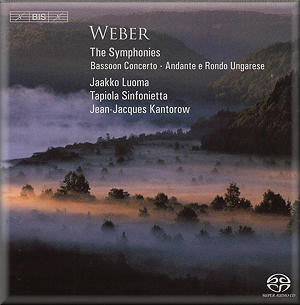 |
 |
|


alternatively
CD:
AmazonUK
AmazonUS
Download: Classicsonline
|
Carl Maria von WEBER (1786-1826)
Symphony No.2 in C major, J51 (1808) [18.11]
Andante e Rondo Ungarese, J158 for bassoon and orchestra (1809/1813) [9.03]
Concerto in F major for Bassoon and Orchestra, J127 (1811, rev.1822) [16.45]
Symphony No.1 in C major, J50 (1807-1808) [22.36]
 Jaakko Luoma (bassoon) Jaakko Luoma (bassoon)
Tapiola Sinfonietta/Jean-Jacques Kantorow
rec. March and May 2006 Tapiola Hall, Espoo, Finland, April 2008, Sello Hall,
Espoo
 BIS BIS-SACD-1620 BIS BIS-SACD-1620  [67:42] [67:42] 
|
|
|
These works were all written between 1807 and 1811, so
pre-date Weber’s fame as an opera composer. He had just
left Breslau, having survived a dreadful accident when his father,
a printer,
left a nitric acid solution in a wine glass which his son absent-mindedly
then drank. His next post was a temporary one, when he went to
Bad Carlsruhe and the court of Count Eugen Friedrich of Württemberg-Őls,
who, being himself a fair oboist, encouraged Weber to compose.
Both symphonies were written there during these idyllic few months,
the first in C major in December 1807 and January 1808, the second
(also in C major) later the same month. Reflecting the resources
he found there, the scoring lacks one flute and most surprisingly
there are no clarinets. Solos for the rest abound however, some
of them very demanding, so standards must have been high. Obviously
the oboe has his plate full, but the remaining winds, particularly
the bassoon, are active, so too the French horn and some solo
strings; in fact pretty well everyone has their fifteen seconds
of fame. Written when Beethoven’s first three symphonies
were already known, it is important to regard Weber’s more
in Haydn’s style, with the crossing of the cusp between
Classic and Romantic reflected more by orchestral colour than
any disturbance of formal structure. Even so, these are not predictable
works, in particular the finale of the Second, which stops and
starts for individual solos before scampering on to the next
pause like an American football game. This is Haydn’s wit
at work. Much the same can be said of the First Symphony, which
highlights individual wind players once again. It is full of
confident orchestral outbursts on the one hand - the opera conductor
here - and charming melodies of an almost rustic hue. At a minute
and a half, the Minuet and Trio of the Second Symphony must be
the shortest ever. Note that this recording inexplicably starts
with the Second Symphony and ends with the First, easy to miss
that as both are in the same key.
The rest of the fare is devoted to two concerted works for bassoon
and orchestra. The brief Andante and Hungarian Rondo was
originally composed in 1809 for Weber’s violist brother
Fritz, while the bassoon transcription was made for the virtuoso
player Georg Friedrich Brandt with some inevitably consequent
changes. The Rondo’s rhythms emphasise the Hungarian
flavour of the music. Weber’s writing exploits fully the
facility of the instrument, its agility over a wide range of
notes, tonal quality, and its lyrical as well as comical element.
It was in March 1810 that he found himself conducting a concert
with the Munich Court Orchestra, its programme including a clarinet
concertino he had written for Heinrich Bärmann. Its success
encouraged the orchestra’s principal players to ask for
solo works, so two concertos for clarinet followed in 1811 and,
on 28 December, a bassoon concerto for Brandt. He made some revisions
in 1822, expression and dynamic indications expanded and some
string accompaniments rewritten, and this is the version heard
on this CD.
The performances by Jaako Luoma are finely honed in both works.
His instrument paints a wide palette of colour, his phrasing
is stylish. The Tapiola Sinfonietta under its former (1993-2000)
director Jean-Jacques Kantorow match him in detail in a cleanly
balanced recording. Both symphonies are played with relish, all
solo opportunities exploited to the full. The music is charming,
but Weber is surely still going to be remembered best for his
operas and their overtures, but at least it gives clarinettists
and, in this instance, bassoonists a chance to shine.
Christopher Fifield
|
|

